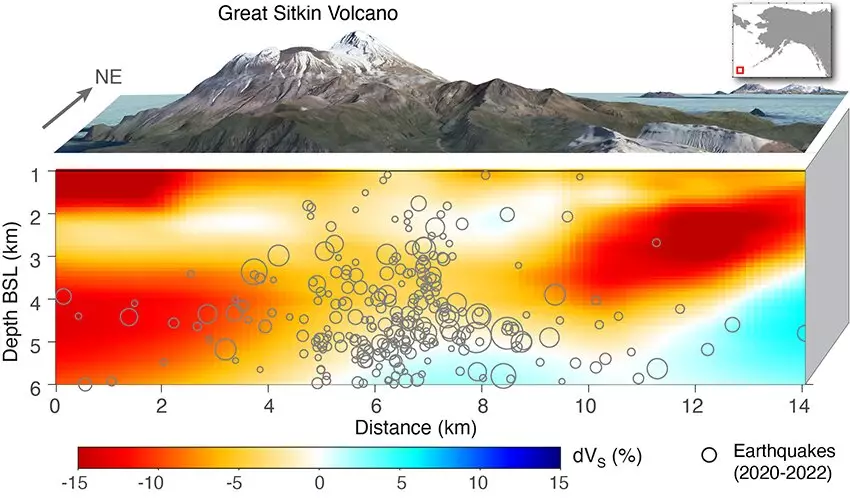Volcanic eruptions can be devastating, causing regional chaos and disrupting weather patterns on a global scale. Scientists study seismic data to measure volcanic activity to better understand the mechanics of a volcano and predict their behavior. The Great Sitkin Volcano in Alaska’s Aleutian Arc has been erupting since May 2021, and the location of intense seismic activity has moved around during that time. A team of researchers led by Dr. Xiaotao Yang, Assistant Professor of Purdue University’s Department of Earth, Atmospheric, and Planetary Sciences, have studied the seismic data and discovered that the Great Sitkin Volcano has not one but two magma chambers bubbling deep beneath the Earth’s surface that have driven the ever-shifting eruption.
The Study
The team of researchers constructed a seismic velocity structure for the uppermost 6 kilometers of the Great Sitkin Volcano, collecting data with seismic data from 2019 to 2020, more than a year before the eruption began, collected by the Alaska Volcano Observatory. The team proposed that the Great Sitkin Volcano has a six-stage eruption cycle, and actually has an additional stage with the second magma chamber kicked in following the initial eruption, likely sourced from the deeper chamber. The tapping of magma chambers has been proposed at other places, and together, this six-stage eruption cycle and the dual-magma chambers explain the evolution of seismicity in space and time across the island and the alternating eruption of two reservoirs.
The team attributed additional observations of the eruption to the presence of dual magma chambers. First, the seismicity at the volcano (before and during the eruption) shows a clear lateral migration at different times. Also, the reservoir to the southeast reached its peak seismicity level one year before the eruption on May 26, 2021, although the initial eruption was companioned by an increased seismicity level only to the northwest of the summit. They also observed that the initial eruption was explosive, although only negligible magma erupted.
The peak lava effusion started about two months after the initial eruption, which left a two-month gap between the initial eruption and lava effusion. This phase of lava effusion coincided with the ramping seismicity to the southeast. About a year after the initial eruption, there was a second phase of lava effusion that is consistent with increased seismicity to the northwest.
“These observations suggest alternating volcanic activity between the two magma reservoirs, which is an important addition we propose compared to the typical stages based mostly on a single-reservoir model or a model involving mostly vertical migration of seismicity,” says Yang. “However, we argue that the phenomenon we observe at Great Sitkin Volcano is not unique to this volcano. It can be generalized to help us understand how multiple reservoirs, which may be in different sizes, could interact and influence the initialization and development of the eruption as well as magma flux.”
Conclusion
The study of the Great Sitkin Volcano demonstrates the complexity of active magmatic systems and the importance of real-time monitoring of active volcanoes, including earthquake activities, gas emissions, surface deformation, and surface temperature, building on top of the knowledge on the distribution of active magma reservoirs. The unpredictable nature of volcanic activity can release lava, ash, water, and gases into the atmosphere quickly or slowly over time. Using seismic data alone is not enough for a thorough investigation, scientists need to monitor other data to better predict how and when volcanoes might erupt in the future.


Leave a Reply